 |
 |
 |
 |
 |
 |
 |
 |
 |
 |
 |
 |
 |
 |
 |
 |
 |
 |
 |
 |
 |
 |
 |
 |
 |
 |
 |
 |
 |
|
Index
|
|
Kazan Real-Estate Server (Russia)
|
- Tours of Dover Castle
- History of Dover Castle
- The keep and inner curtain
- The siege of 1216
- Hubert de Burgh, Chief Justiciar
- Tudor Dover
- Dover and the British Army
- Dover's Contribution to Castle Architecture
- Some my own photos
|
|
Tours of Dover Castle
|
|
Dover Castle
Colin Platt
Dover is a giant among castles. It has the longest recorded history of any major castle in Britain. Yet few legends attach to the castle, and only once was it seriously at risk. Dover is neither romantic nor a place of Gothic horrors. It has long been less a royal residence than a barrack.
Dover began before history itself. Its earliest rampart defences date to the prehistoric Iron Age. Then the Romans built a pharos (lighthouse) here in the first century AD, with another on the facing Western Heights. The same tall headland, already partially defended, was resettled in the tenth century or earlier by the Anglo-Saxons. They built a burh, a fortified town, of which St Mary-in-Castro was the church. Both pharos and church still remain.
The bulk of Dover Castle, as we know it today, postdates the Norman Conquest by a century. Soon after the Battle of Hastings, in the autumn of 1066, Duke William spent eight days at Dover strengthening fortifications which had only recently been rebuilt by the defeated Harold. Yet neither William's works nor those of Harold are identifiable today, and what the visitor now sees of the masonry of Dover is all of the twelth century or later. Most monumental is the great square tower, or keep, built in the 1180s for the Angevin King Henry II (1154-89). Every visit should begin at this point. Also of the 1180s are the walls of the keep's surrounding court (the Inner Bailey), as is a stretch of outer 'curtain' wall towards the cast. The remainder of this substantial outer curtain, with its sophisticated gatehouses and many flanking towers, is chiefly the work of Hubert de Burgh, Constable of Dover (1202-32), and of his successors under Henry III (d 1272).
After the thirteenth century, little of substance was added to Dover before the present barracks were built and the defences remodelled, starting in the 1740s. It was then that Dover, after years of neglect, entered a new lease of life. Georgian and Victorian military engineers stripped Dover bare. The castle lost its patina of age. Yet their achievement has an importance of its own. After Henry II's keep and Hubert de Burgh's curtain, the artillery defences of eighteenth- and nineteenth-century Dover contribute a third major clement to our tours.
|
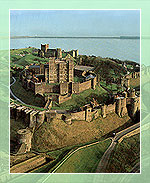
|
|
Dover Castle.
|


|
 |
Dover castle is one of oldest and most important castles. Perched high above the town on an ancient headland, it commands the historic gateway to England.The castle has been in continuous military occupation for over 800 years. Its great tower, or keep, is one of the finest in England.There are many attractions for the visitor.
|
|
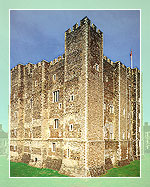
|
|
Keep of Dover Castle.
|


|
 |
The great keep of Dover Castle, built for King Henry II in the 1180s
|
|
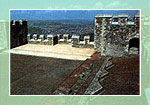
|
|
The roof platform of the keep.
|


|
 |
The roof platform of the keep, strengthened by Georgian military engineers to carry guns, is still the best viewpoint for the town below.
|
|

|
|
Guns.
|


|
 |
Guns are still in place in the upper battery of the caponier. At the far end of the entrance, now closed, to the bomb-proof underground passages and guardrooms of the Redan.
|
|
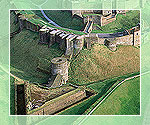
|
|
Hubert de Burgh's triple Norfolk Towers.
|


|
 |
Hubert de Burgh's triple Norfolk Towers (top centre) closed the earlier northern gate undermined in the siege of 1216. In front of them is the circular St John's Tower (centre) and the triangular beak of the Redan. Note the levelling of all towers along this length of the outer curtain to improve the eighteenth-century gunners' field of fire.
|
|
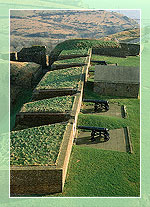
|
|
Bell Battery.
|


|
 |
Bell Battery, originally of six guns, was an early attempt by the Army's engineers to counter the threat from the rising ground on Castle Hill. It dates to the first programme of re-fortification in the 1750s.
|
|
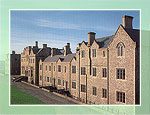
|
|
The Officers' Mess.
|


|
 |
The Officers' Mess, a Victorian building, gives fine views of the harbour and town. It was designed by Anthony Salvin who also did restoration work at the Tower of London and built Peckforton Castle.
|
|
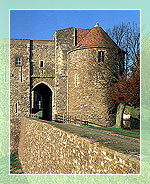
|
|
Peverell's Tower.
|


|
 |
Peverell's Tower is a gatehouse of two periods. On the left is a big mural tower of King John's reign, at what was then the south-west angle of the outer curtain. The semi-circular tower on the right was added in the thirteenth century. Its conical roof probably dates to about 1300.
|
|

|
|
Constable's Gate.
|


|
 |
Built in the 1220s as the new castle entrance, Constable's Gate was certainly the greatest gatehouse of its day. Made up of five towers, it projects forwards over the moat, furnishing flanking fire along the walls. Over the gate passage were the quarters of the Constable, Hubert de Burgh - defender of Dover in 1216 and chief architect of the new defensive system.
|
|
|
History of Dover Castle
|
|
The keep and inner curtain
No castle has only one purpose, and Dover's has never been just defence. Henry II's great keep at Dover, both the last and the most ambitious of its kind, has sometimes been seen as an anachronism: out-of-date before even begun. Certainly, it recalls in many details the much earlier tower keeps, among them Rochester and Norwich, built two generations before in the reign of the king's grandfather, Henry I (1100-35). Yet Henry II and his builder, Maurice 'the Engineer', knew very well what they were doing. Henry, who had been brought up in Anjou, spent much of his reign in France: that great laboratory of castle-building in the Middle Ages. Almost twenty years before, for far less money than he would spend at Dover, he had built himself an experimental castle (never repeated in plan) at Orford in Suffolk, which was right up with the latest French fashions. But Dover was a different and greater challenge. The castle was a prestige project, certain to be of high visibility to Henry's enemies. Hubert de Burgh, not many years later, was the first to call Dover 'the key of England'. And so, even as late as the Second World War, it remained.
Henry spent a fortune on Dover: almost an entire year's revenue in total. What resulted was a huge square keep, more sophisticated than it looks, wrapped around by the walls of a multi-towered bailey, similarly characterised by innovation. Brave show was obviously one of the new castle's purposes. Another was the provision of suitable accommodation for the king and for those who rode with him on his travels. Stark though it now seems, there was more than one touch of luxury in Henry's keep. It was supplied, most exceptionally for a building of that date, with piped water from the well. It was adequately equipped with lavatories, built into the thickness of the walls. There were individual fire places in the royal bedchambers. The keep's two chapels, especially the Upper Chapel which was Henry's own, were finished with appropriate refinement. Two big spiral staircases, at opposing angles of the keep, linked every floor, while another great stair, rising in straight flights through the triple-towered forebuilding, gave direct external access to the second storey.
As advanced as the great tower, and no less monumental, were the defences of Henry II's Inner Bailey. There are no fewer than fourteen regularly spaced flanking towers along the line of the inner curtain at Dover. Henry had used such towers, enabling cross-fire along the walls, at other new castles including Orford. But he had never placed them as systematically as he would at Dover, nor built them on a comparable scale. Pairs of towers, in the north and south walls, protected the gates known as King's Gate and Palace Gate respectively. They are the earliest English gatehouses of that plan.
So much of Dover has been repeated at later castles that it may appear more commonplace than it is. Yet no English tower keep, before Dover's time, had been of equal ambition or complexity. No castle had been equipped with comparable gatehouses, nor with flanking towers of such number or such scale. Even that was not all. In the new outer curtain, planned and begun before Henry's death, Dover anticipated by a century the most sophisticated concentric castles of the later period. It was this outer defensive circuit, extended by King John, which held fast in the siege of 1216.
|
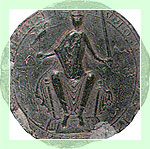
|
|
Henry II.
|


|
 |
Henry II, portrayed on his seal, delivers justice to the people.
|
|
|
The siege of 1216
The Great Charter (Magna Carta) of 1215 was a monument to individual freedom. It has been cited ever since by those in England who have preferred the rule of law over tyranny. Yet in its own time Magna Carta brought peace for just ten weeks. What had been agreed between King John and his barons in June 1215 was already unworkable by August. By October at latest, the nation was in open civil war.
King John, nicknamed 'Softsword', was no general. 'No man may ever trust him', sang Bertrand de Born, 'for his heart is soft and cowardly.' Yet his barons had great difficulty unseating him. Fearing worse things, the rebels offered the English crown to Prince Louis of France, on condition that he came and took it for himself. In May 1216, a French army landed on the south coast.
|
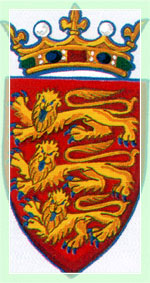
|
|
King John.
|


|
 |
The lions of England: the arms of King John.
|
|
|
And Louis, before long, controlled much of southern England, including the rebel stronghold of London. Only the royal castles at Windsor and Dover held out. Both were besieged in late July, but neither fell to the French. Windsor was relieved in mid-September. 'Long were they there', wrote the chronicler, 'and little did they gain'. Dover, invested by Prince Louis himself, was in severe difficulties a month later, but was saved by John's death and a truce. It was at the North Gate — later blocked and rebuilt as the Norfolk Towers — that Louis directed the main thrust of his attack. He first took the gate's outworks, then dug a mine below one of its towers, causing the whole structure to collapse. Hubert de Burgh, defending Dover for King John, blocked the breach temporarily with timber. Nevertheless, the situation had become desperate by mid-October when John, lying at Newark and grievously sick, expired on the wings of a whirlwind.
John's death, during that wild midnight storm on 18 October, was not the end of the civil war he had provoked. For many months yet, the struggle was continued under such picturesque figures as Willikin of the Weald, the royalist guerilla leader, and Eustace the Monk, Louis's admiral. Dover Castle itself, in the spring of 1217, was again under siege by Prince Louis. But its defenders had little to fear. French defeats at Lincoln in May and at sea off Sandwich in August, when Eustace was beheaded on his own ship, compelled Louis and his English allies to accept a settlement. Louis withdrew, but not without honour. Magna Carta was reissued. John, 'nature's enemy', was dead.
|
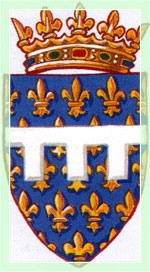
|
|
Prince Louis.
|


|
 |
The fleurs-de-lis of France: the arms of Prince Louis.
|
|
|
Hubert de Burgh, Chief Justiciar
After King John's siege of Rochester in the autumn of 1215, 'there were few who would put their trust in castles.' Yet he himself put his trust in Dover, and all the siegecraft John had shown in the assault on Rochester was re-applied against his own garrison a year later. At both castles, in particular, the undermining of towers brought about serious collapses. The lesson was not lost on John's heirs.
Hubert de Burgh, Dover's defender, was a veteran who had seen service under the crown since the reign of the late King Richard (d 1199). In 1204, in a rare heroic episode of John's otherwise disastrous Poitou campaign, Hubert had held Chinon for a twelvemonth against the French. As Chief Justiciar of England from 1215, Hubert commissioned castles — Montgomery, Grosmont and Skenfrith among them — which were as advanced as any of their day. Dover benefited also from his skill.
Rochester's loss to its besiegers had begun with a breach in the keep's surrounding curtain. At Dover, it was the outer gatehouse that had very nearly fallen to Prince Louis. Accordingly, Hubert de Burgh's subsequent emphasis at Dover was all on strengthening the castle's outer curtain, without which the keep (as at Rochester) would be a trap. The direction of castle architecture was anyway changing, giving less prominence to the keep. In Hubert's hands, Dover became a castle entirely on the offensive.
Dover's problem had always been the rising ground to the north and north-east of the promontory. To counter this, Hubert blocked the existing north gate, already badly damaged in the siege, and re-sited the castle's entrance towards the slopes on the west, combining it with lodgings for himself. Constable's Gate, still in use, was one of the pioneer residential gatehouses of its era. It was protected externally by a strong defensive outwork. It had a drawbridge, a portcullis, and a long entrance passage. Its towers projected forward over a steep-sided moat to furnish flanking fire along the curtain.
Similarly sophisticated were Hubert's works on the vulnerable northern quarter of the fortress: on the outworks and blocking towers (Norfolk Towers) of the former north gate, and on the new postern (Fitzwilliam Gate) to the north-east. Pointed, beak-shaped profiles characterised Hubert's towers. They were of the latest French fashion, designed to resist undermining. Other measures were taken to prevent an enemy coming too close. Hubert, in his experience whether at Chinon or at Dover, had learnt the value of sorties. To facilitate these, he equipped Dover with its unique system of underground works, each of them issuing in a sally-port. There is a chalk-cut underground passage, beyond the moat, at the far end of the Fitzwilliam Gate barbican. Another passage opens below the drawbridge of Constable's Tower. A third, linking the Norfolk Towers to Hubert's outlying earthwork spur, developed into a whole system of subterranean works, protected in mid-moat by St John's Tower. Any besieging army, after Hubert's day, was more vulnerable than the garrison within. It was exposed to assault at all times and from many different quarters. What it confronted was a fighting machine.
|
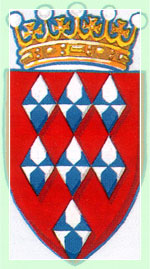
|
|
Hubert de Burgh.
|


|
 |
The arms of Hubert de Burgh, Constable of Dover and Earl of Kent.
|
|

|
|
A thirteenth-century knight.
|


|
 |
A thirteenth-century knight: the effigy of Sir John d'Abernon. A brass from the Church of St Mary in Stoke d'Abernon.
|
|

|
|
Constables Gate.
|


|
 |
Hubert de Burgh's purpose in re-siting the main gate was to remove it from the domination of the high ground to the north and to re-establish Dover's entrance on the steep western slope, out of range of contemporary siege engines. Constables Gate today is much as he left it in the 1220s, though modernised above gate-passage level to provide lodgings for the Deputy Constable.
|
|
|
Tudor Dover
Dover Castle, by the sixteenth century, had ceased to be much regarded as a fortress. Although garrisoned still and kept in fair order, Dover played little part in the fortification programmes of Henry VIII's latter years, when the old king's system of continental checks and balances eventually collapsed at his feet. Threatened by the combined might of the pope's allies — by France and by Spain in rare union — Henry VIII poured every resource of the English crown into the construction of a chain of coastal batteries. Dover, surrounded by such works, was not one of them.
The reason for this was its remote and lofty position. At Dover today there is a fine gun of the period, known incongruously as Queen Elizabeth's Pocket Pistol. It dates to 1544, was made in Utrecht as a gift to Henry VIII, and carries an inscription which reads (in translation): 'Breaker my name of rampart and wall/Over hill and dale I throw my ball'. The Pocket Pistol has a barrel of extreme length. It could throw its ball over a distance (some say) of seven miles. In contrast, contemporary ordnance of more conventional design had to get very much closer to its target.
One consequence was that Henry VIII's new forts were constructed for the most part at sea level, where they could do battle, gun for gun, with hostile shipping. At Dover, there were three Henrician batteries, all of them down by the harbour. And the only known modification of the castle itself was the Tudor Bulwark, a gun platform towards the south-west corner of the outer curtain. Henry preferred to concentrate his energies elsewhere. Just up the coast, on the sea front at Deal, is one of the earliest and most expensive of Henry's forts, built in 1539-40. Deal Castle is typical of its period, geometrically perfect in plan. Six great circles interlock and are meshed like the cogs of a wheel. Five stacked fighting platforms carry a total of 145 gun embrasures. Nothing better illustrates Henry VIII's obsession with artillery, nor his lack of regard for its cost.
|
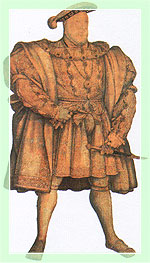
|
|
Henry VIII.
|


|
 |
Henry VIII as portrayed in the drawing by Hans Holbein the Younger.
|
|

|
|
Deal Castle.
|


|
 |
The geometrical plan of Deal Castle.
|
|

|
|
Artillery.
|


|
 |
Henry VIII had a particular interest in artillery. This great bronze basilisk, 7.3m in length, was presented to Henry by the Emperor Charles V.
|
|
|
Dover and the British Army
At medieval Dover, defence had concentrated on the castle promontory. Modern Dover saw a new shift of emphasis towards the port. Already, in the sixteenth century, some of this re-shaping had begun. Archcliffe Fort (below Western Heights), Black Bulwark (to its east), and Moat's Bulwark (to the east again, below the castle), covered the Tudor harbour between them. Later generations, most particularly from the 1780s, continued and developed these beginnings.
Dover Castle, in the meantime, rose to brief prominence in 1625 as the reception-point for Charles I's new queen, Henrietta Maria of France. To receive her, the ancient keep was redecorated and refurnished. Moulded plaster ceilings with painted cornices were installed in the royal apartments. At the entrance, a fine stone portico — a 'greate Rusticke (rusticated) Dore' — was constructed, ornamented with 'Rusticke pillausters, and sondry mouldings, and Cornishes', probably to a design by the King's Surveyor, Inigo Jones. Yet the queen and her party remained unimpressed. And whether for this reason or another, Dover entered its long sleep from that time forward, reviving only temporarily for the Civil War (1642-49).
It was another invasion threat, not unlike that of 1539-40, which brought Dover back to life in the 1740s. By 1744, France and Spain had once more united against England. There was a Jacobite army, under Marshal Saxe, mustering ominously at Dunkirk. Over the next decade, until 1756, Dover Castle was fully garrisoned, while its troops were kept busy throughout that period on the modernisation of the medieval defences. For the last time, it was the castle itself which received the lion's share of attention.
New barracks (the Keep Yard barracks) were built against the walls of Henry II's Inner Bailey. Then batteries were constructed to command the north-east quarter: six guns at Bell Battery, another four north of the church and pharos. It was during this campaign that the systematic mutilation of the medieval fortress first began. Along the north-east curtain, between Fitzwilliam Gate and Avranches Tower to its south, two late twelfth-century flanking towers were demolished to rampart-level. Dover's blunted profile, as we know it today, is entirely the work of artillerymen.
Further demolitions were required by later gunners, under pressure once again of invasion threats during the Revolutionary and Napoleonic Wars (1793-1815). And Dover Castle, before 1805, had lost all but a few of its upstanding towers, cut off short to improve fields of fire. Even the keep had been bomb-proofed with ugly brick vaults and brought into service as a gun platform. In addition, new artillery bastions had been constructed, with their own elaborate underground works — Constable's Bastion to the west; Horseshoe Bastion, Hudson's Bastion and East Demi Bastion, along the still vulnerable eastern flank. Gun-carrying caponiers had been laid across the moats, one of these below Canon's Gate, itself newly cut as a carriage and troop entrance to the Outer Bailey.
These improvements at Dover Castle were expensive. Yet they were far less costly than contemporary activity on the opposing Western Heights, a huge defensive complex begun in the early 1780s. This new artillery citadel, on the other side of the town, complemented rather than superseded the medieval castle. Nevertheless , it opened a fresh chapter in Dover's defence, in which the role of the older fortress became less central. When eventually, after many delays, the works at Western Heights were finished in the 1850s, they were immediately succeeded by other major projects, only few of which touched Dover Castle. Most important of these, remedying an old lack, was the building (from 1860) of Fort Burgoyne, on the high commanding ground to the castle's east. Most ingenious was the great steam-driven revolving turret down on Admiralty Pier, armed with its pair of eighty-ton 16-inch guns. Many of these works can still be inspected from the walls of Henry II's fortress. Their sequence ends today with the Admiralty Lookout and Signal Station (below the castle on the south), last military link in a chain of rare length, from the twelfth century to the Second World War.
|

|
|
Engraving.
|


|
 |
In this 1735 engraving, Dover Castle (top right) is shown shortly before its transformation for artillery. Its towers and east curtain (later hidden in the rampart) are still standing at their full height.
|
|

|
|
Henrietta Maria.
|


|
 |
Henrietta Maria, Charles I's bride, was not much taken by Dover. Her chamberlain wrote: 'The castle is an ancient building constructed after the manner of olden days, in which the queen was ill lodged in poorly furnished apartments, and her retinue treated with very little magnificence considering the importance of the occasion.
|
|
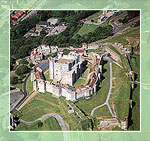
|
|
Dover Castle.
|


|
 |
The early concentric defences of Henry II's castle at Dover, finished off by John, are clearly seen in this aerial view of the fortress. North from Avranches Tower (bottom right), a long stretch of the outer curtain had been completed before Henry's death. Hubert de Burgh's innovatory residential gatehouse at Constable's Tower (top left) was Dover's second major contribution to castle architecture.
|
|
|
Dover's Contribution to Castle Architecture
Dover twice set the pace in medieval castle architecture, before gunnery drove the fortress underground. Both occasions were accompanied by heavy expenditure, most particularly on the outer defences.
The first of these campaigns, initiated by Henry II, included the construction in the 1180s of the great keep. But there was little that was novel in a building of this kind, apart from its size and its luxury. In contrast, the number and regular spacing of the interval towers on Henry's Inner Curtain were virtually unprecedented in his kingdom. Dover's even more ambitious Outer Curtain, begun before Henry's death and continued by his sons, heralded a new era in castle planning.
Concentric defence in this mode, where a high inner wall overlooks and commands its outer ring, took a further full century to perfect. Edward I's North Welsh castle at Beaumaris, begun in 1295, was never bettered afterwards by fortress-builders. In the meantime, however, Dover had established another major first in military engineering. Dover's greater gatehouses were all rebuilt by Hubert de Burgh, following his siege experience in 1216 when the castle had nearly fallen to Prince Louis. The residential gate house (Constable's Tower) and the sophisticated stone barbican (St John's Tower and Fitzwilliam Gate), each set a standard for later imitators. From that time forward, the keep lost much of its priority in defensive systems, to be replaced almost everywhere by the gatehouse. Dover had met and had overcome its last challenge.
|
|
Some my own photos
|
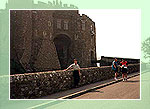
|
|
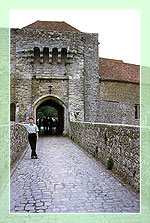
|
|

|
|
|
 |
|
 |





